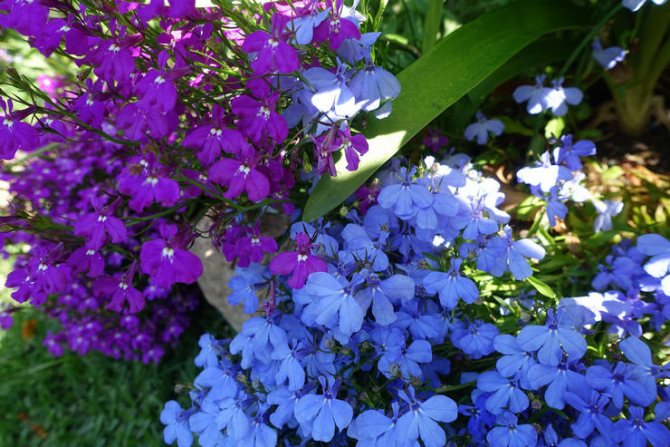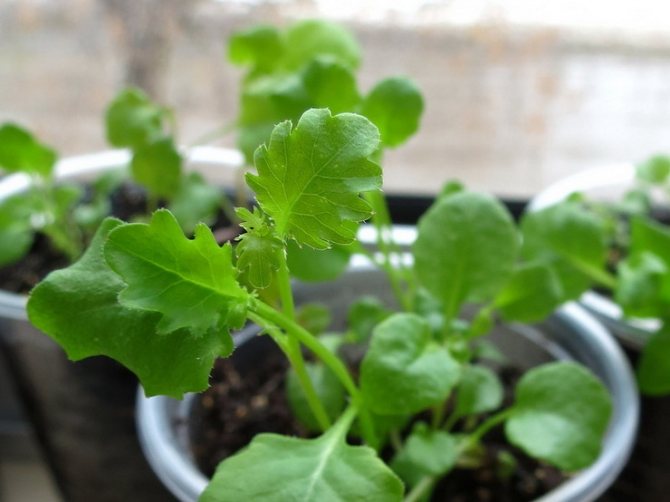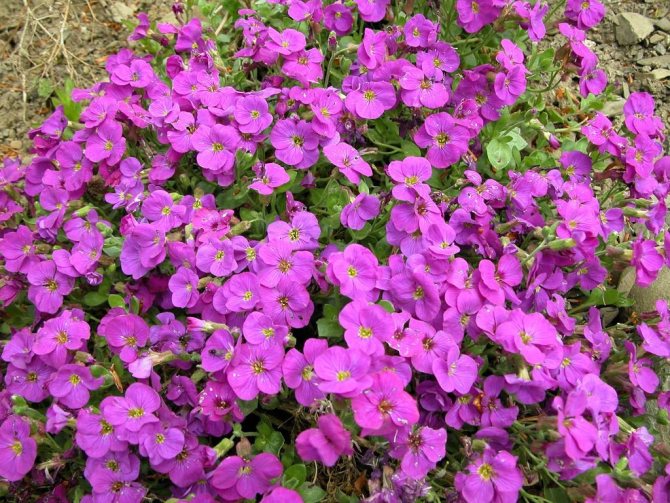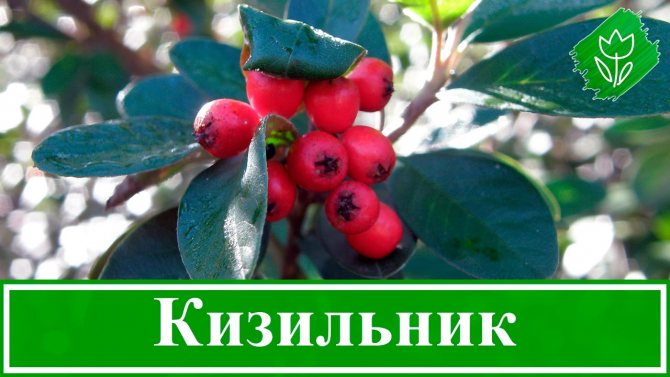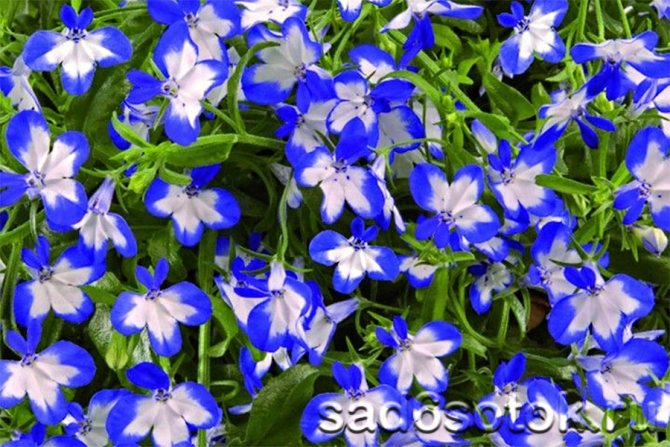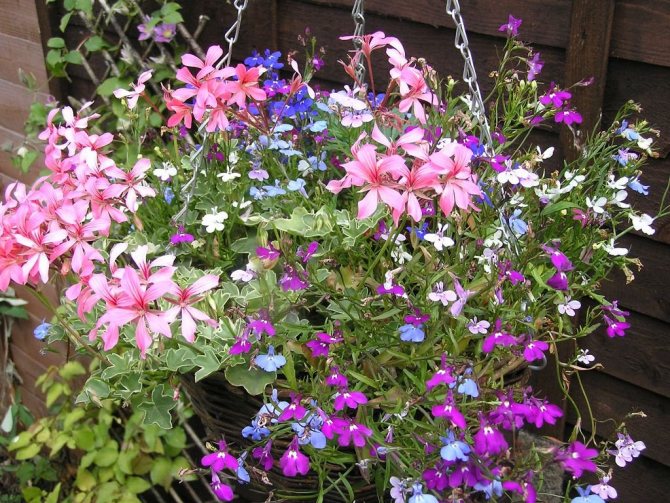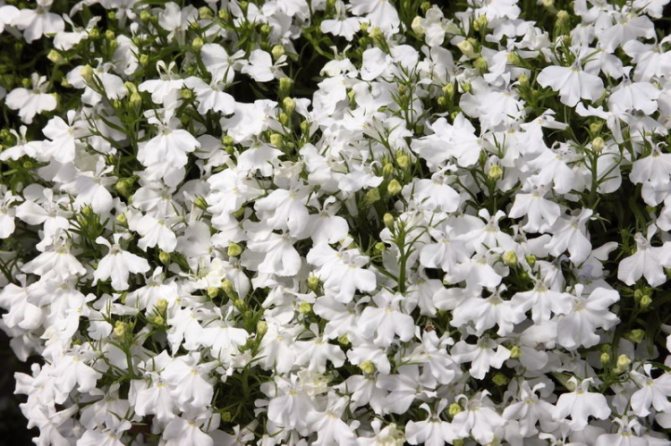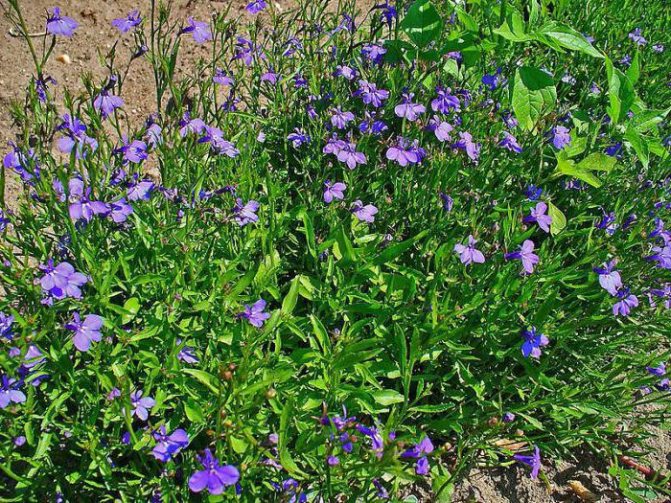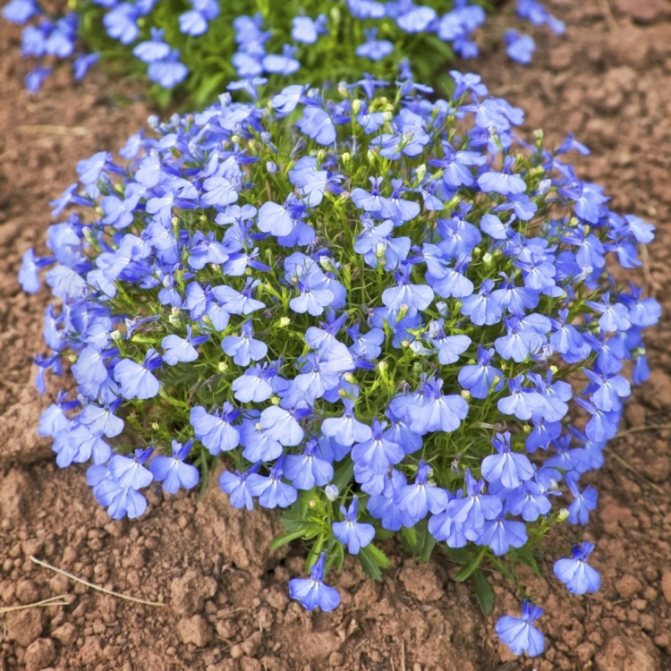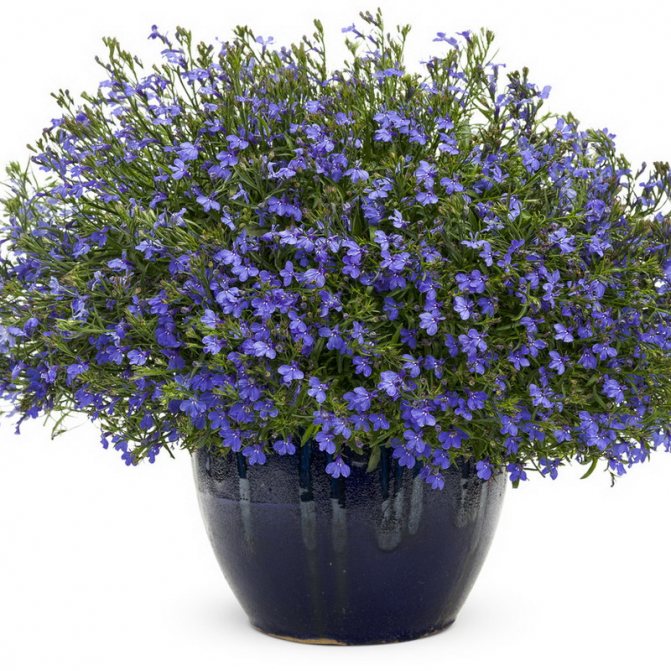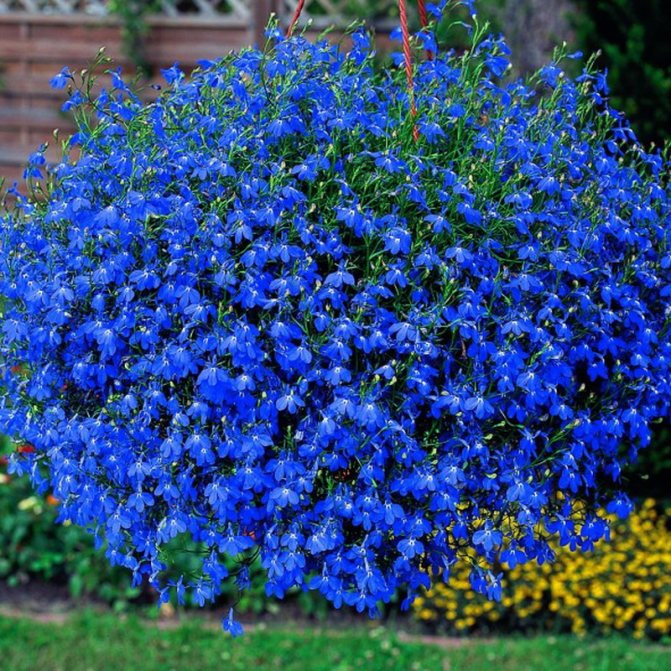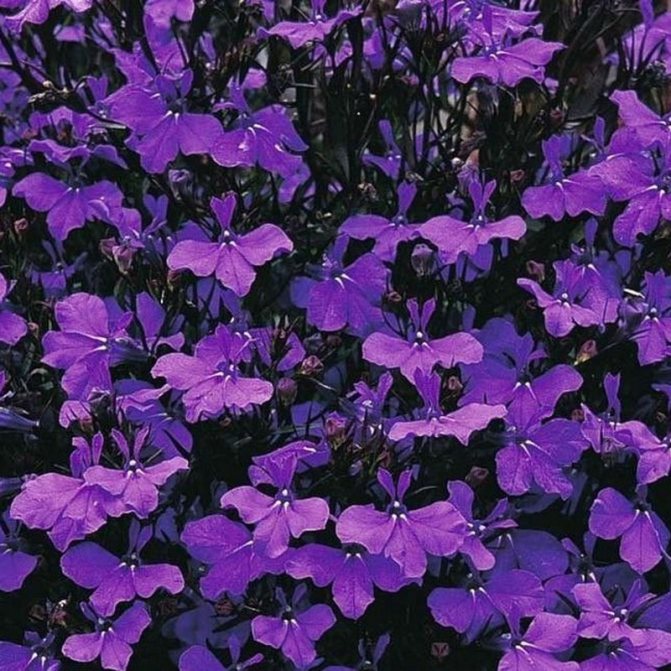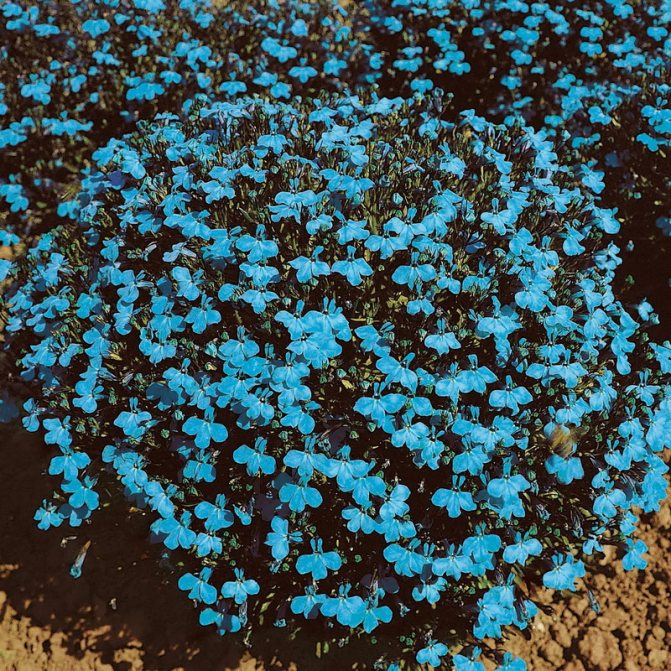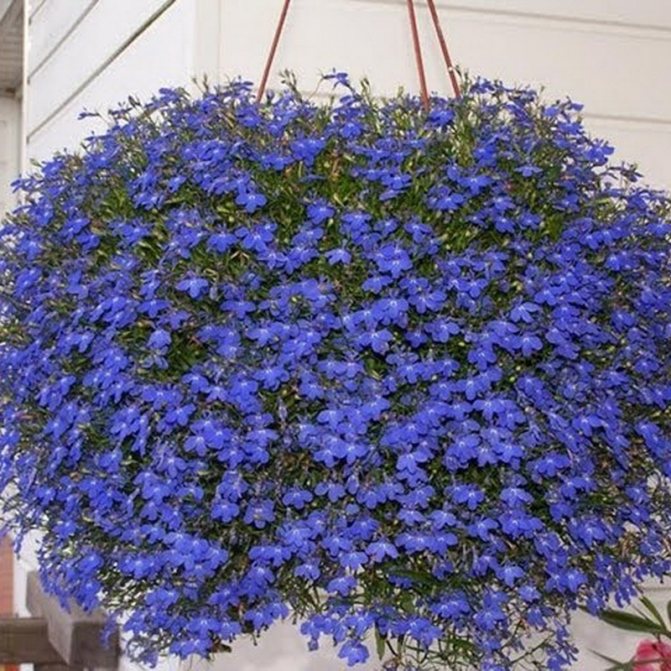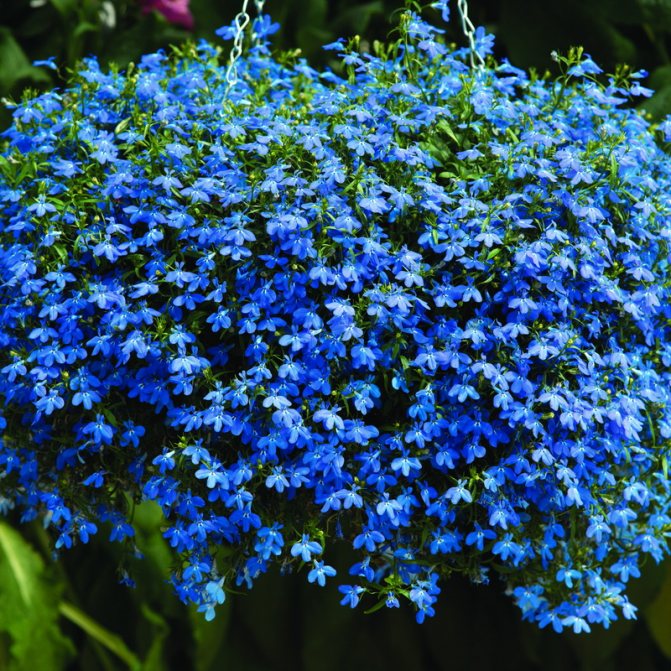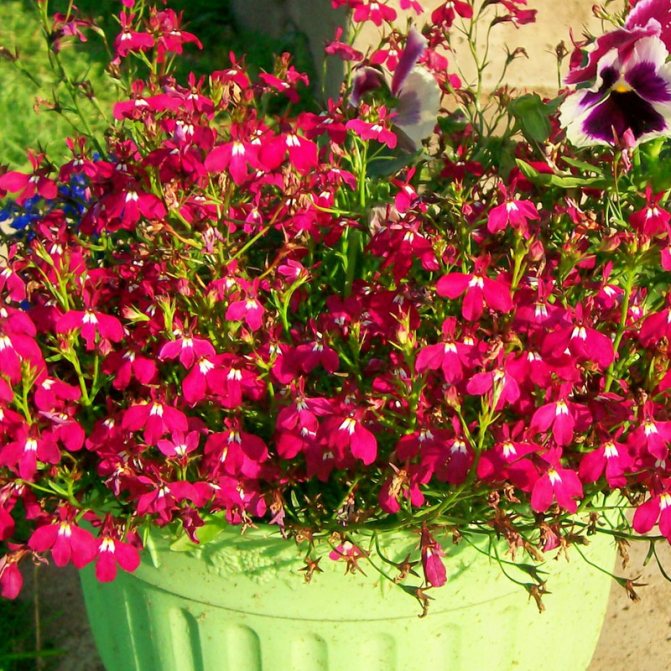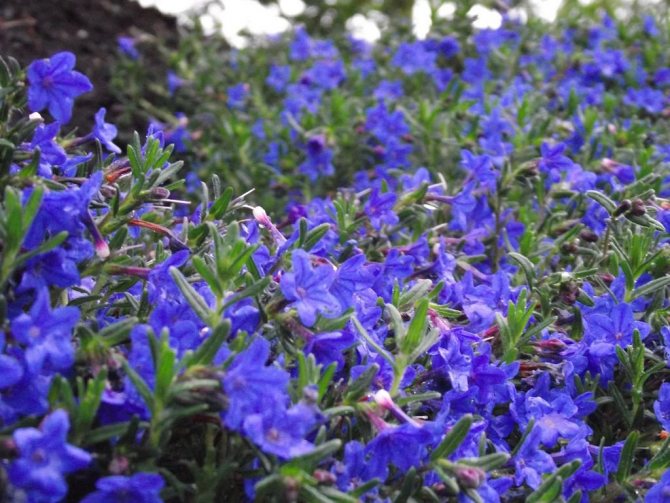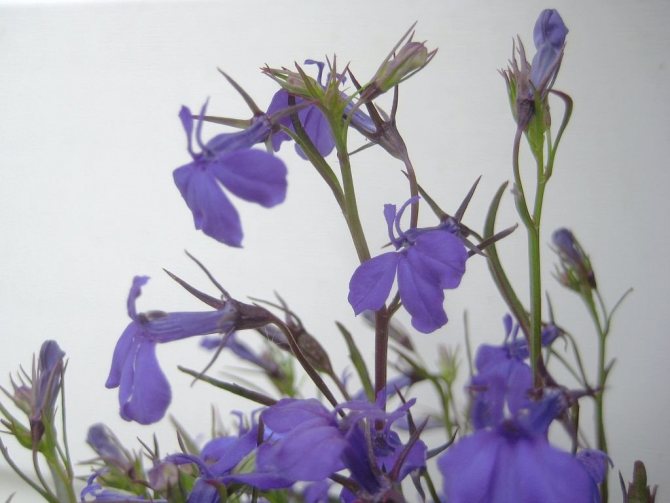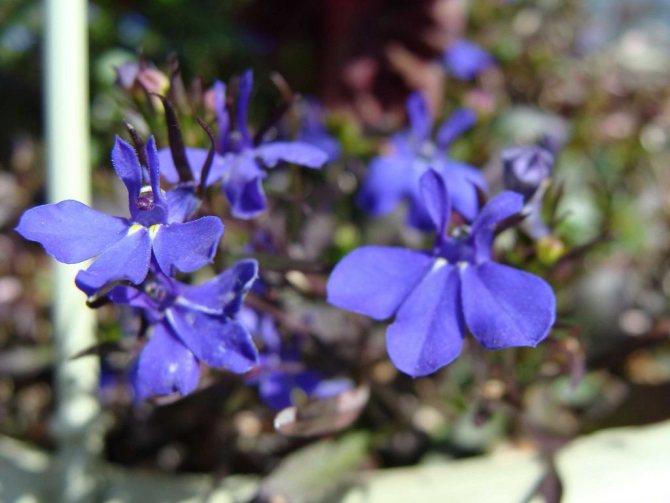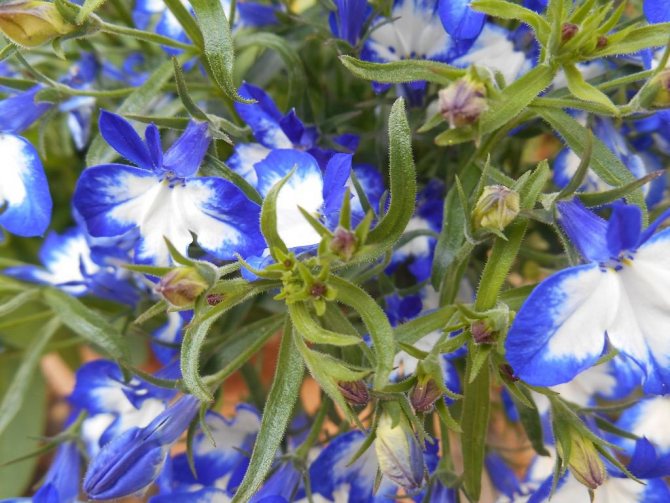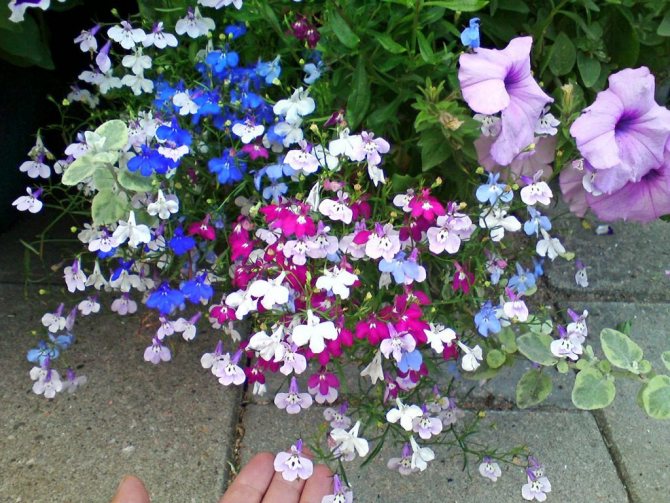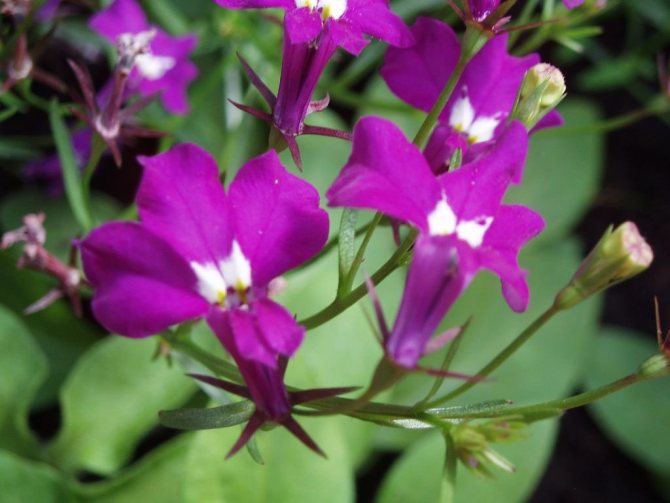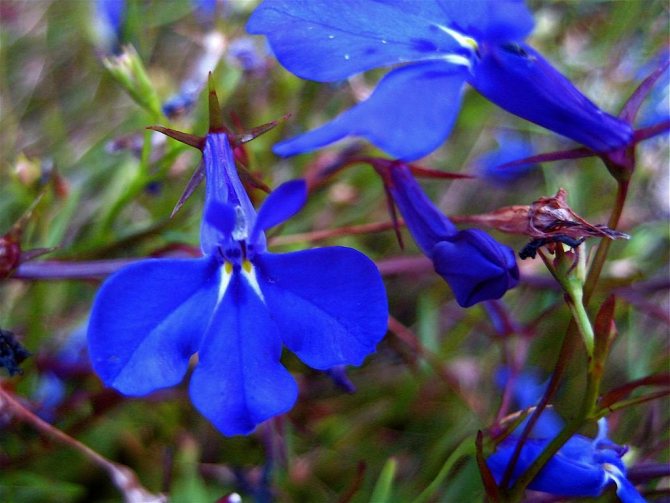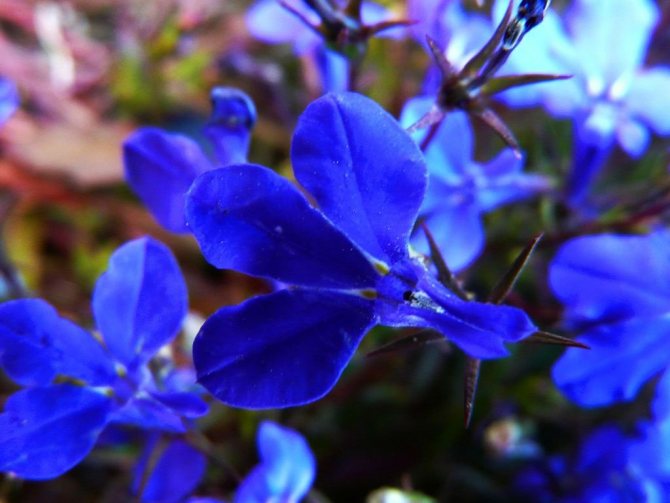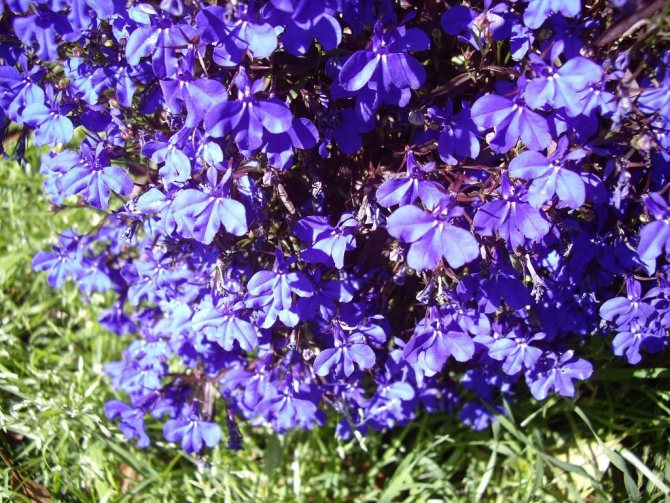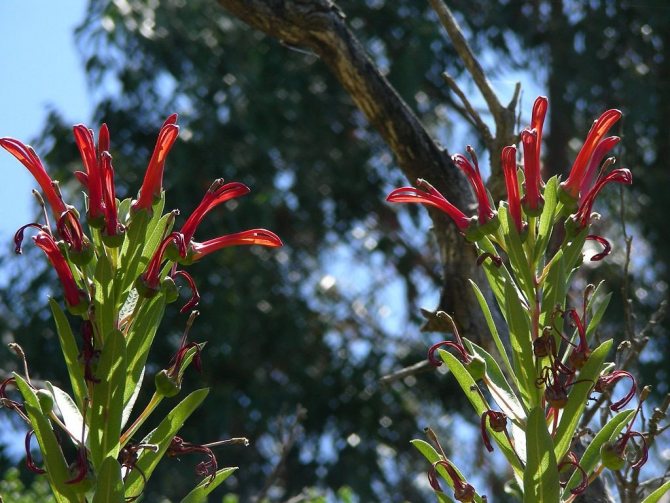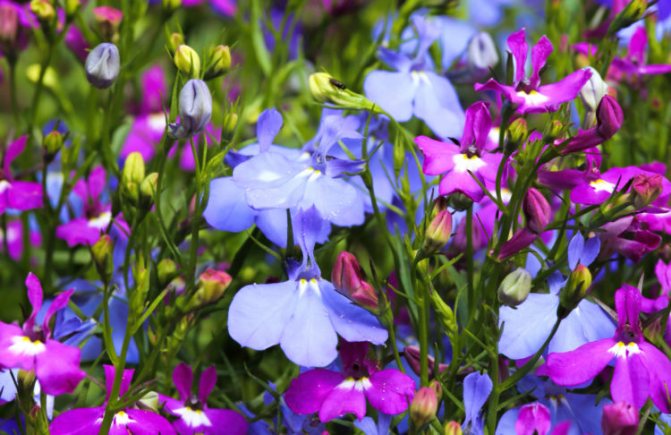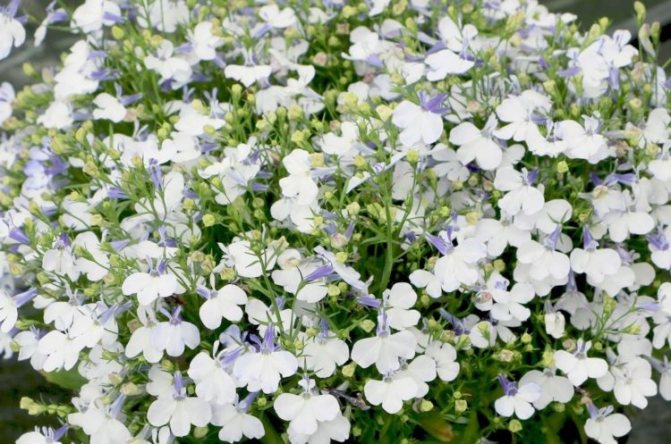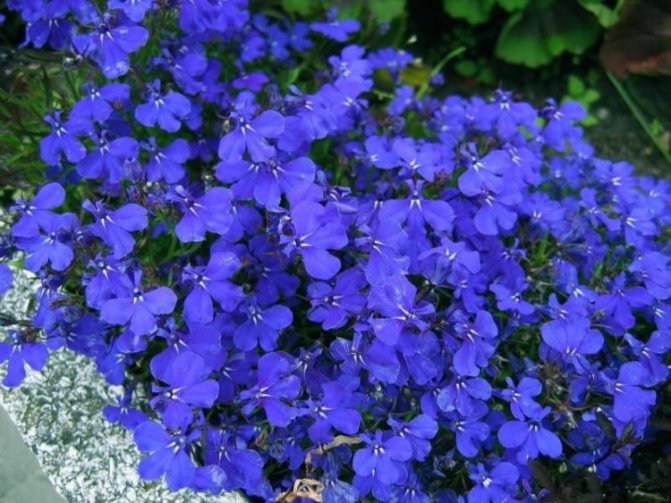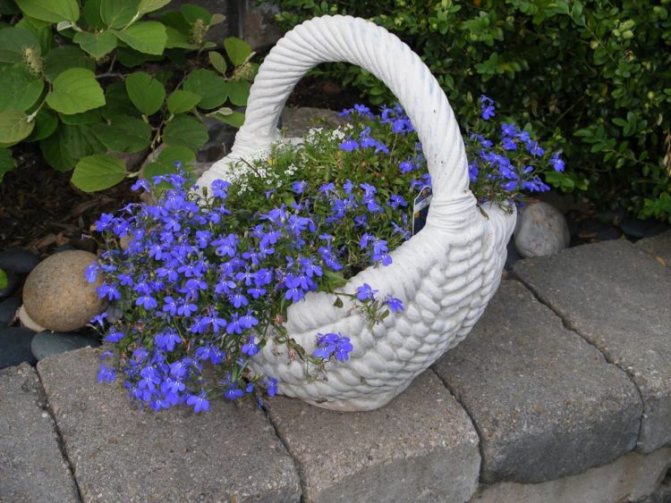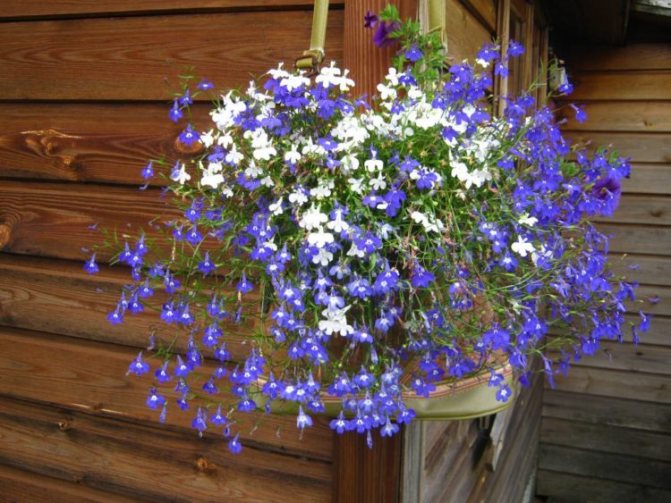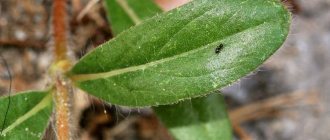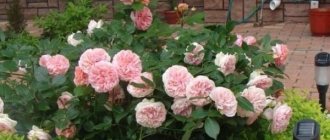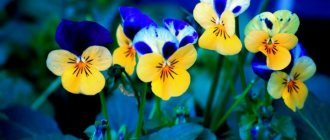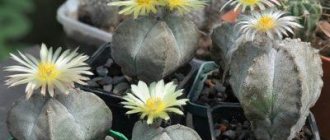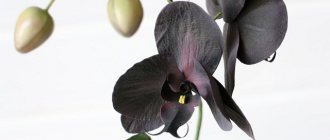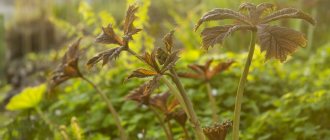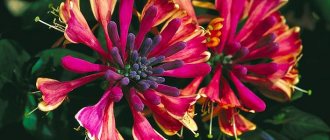This wonderful flower is good everywhere. He will decorate a carpet flower bed, will be a companion for matricaria, marigolds, salvia, petunia, alyssum and other plants. Lobelia lobelia looks wonderful in hanging pots and baskets, both alone and in a company with other flowers
Lobelia is valued for its amicable, abundant and long (until frost) flowering. She is irresistible in her blue and light blue outfit. If the container with lobelia is brought into a warm room before freezing, it will continue to bloom like a houseplant.

Lobelia Erinus
Lobelia got its name in honor of the botanist De Lobel. The extensive genus Lobelia (Lobelia) has many annual and perennial herbaceous plants. But in culture, Lobelia erinus is mainly widespread. It is a perennial that is cultivated as an annual in the temperate zone.
Lobelia erinus is a small, highly branching, densely leafy plant, abundantly covered with small (1–1.5 cm) flowers of white, blue, blue, pink color. The plant can be in the form of a ball with a diameter of 10-25 cm or form hanging shoots up to 30-40 cm long. Such forms are called ampelous. Its branches, adhering to the ground, are able to form roots. The leaves of the plant are small, ovoid, with jagged edges. Lobelia blooms from June until frost.
Gardeners most often have five garden forms of lobelia erinus, differing in the habit of the bush:
- spreading lobelia - 15 cm high and 15-30 cm long shoots;
- lobelia compact - dense, almost spherical bush, 15–20 cm high;
- erect lobelia - 20–25 cm high; dwarf lobelia - with compact bushes 8–12 cm high;
- hanging lobelia - ampelous form of lobelia.
|
|
Lobelia care
Lobelia is a genus of annual and perennial herbaceous plants that belongs to the bellflower family. Lobelia has more than three hundred species. Lobelia is native to tropical and temperate countries: Asia, South Africa, Australia, New Zealand. In the wild, it grows in humid and rocky places. The lobelia has an erect tetrahedral stem. The root system is fibrous. Leaves are 3 to 8 cm long. The top side is darker than the bottom. Flowers are bell-shaped, two-lipped. The color of flowers is predominantly cold tones: shades of blue, violet, purple. However, there are varieties and warm colors.
Watering mode
Lobelia loves high humidity, so you need to water it regularly, but in moderation. Daily watering will be sufficient, adjust your watering frequency according to the weather conditions. In hot weather, you may need to water it twice a day.
In no case should foliar irrigation be applied to lobelia - this can lead to plant diseases.
Illumination requirements
Lobelias prefer diffused consecration, so try to shelter them from direct midday sunlight. Also, you can choose a shade-loving type of lobelia that will grow easily in partial shade. When growing seedlings, they need to be kept on the windowsill so that the plants receive their dose of sunlight. If your windows face north and there is little light, it is recommended to additionally use artificial lighting.
Temperature regime
During the period of seed germination, the temperature must be maintained within 18-20 degrees, then they will germinate in about one to two weeks.If the temperature is higher, they will germinate faster. Once the seeds have sprouted, you can gradually lower the temperature to 15 degrees. When landing in open ground, the temperature at night should not drop below +3 degrees. If the sudden frosts have passed - do not worry, some varieties are able to withstand temperatures down to -1 degrees, provided that you have hardened them.
Soil
The ideal soil for lobelia is light sandy loam with a neutral and slightly acidic reaction of the environment. If your soils are too acidic, add lime (at the rate of 1/3 of lime per 1 part of soil). If they are too heavy, add one part sand, one part peat and one part soil.
It is not necessary to apply a lot of nitrogen-containing fertilizers (rotted manure and compost), this provokes the growth of foliage and stems, which inhibits flowering.
Top dressing
During the period of growing seedlings and picking, you do not need to feed, since the soil contains all the necessary substances.
You need to feed lobelia with complex fertilizers 3 times during the growing season:
- The first time a week after transplanting into open ground (liquid complex fertilizers);
- The second during the budding period (use complex fertilizers with a low nitrogen content);
- The third - during the flowering period (use the same fertilizers as the second time).
Views
The genus includes over 400 species.
|
|
- Lobelia tupa
- Lobelia erinus
- Lobelia laxiflora
- Lobelia rhynchopetalum
- Lobelia cardinalis
- Lobelia chinensis
- Lobelia deckenii
- Lobelia excelsa
- Lobelia niihauensis
- Lobelia pedunculata
- Lobelia siphilitica
- Lobelia tupa
Lobelia transplant
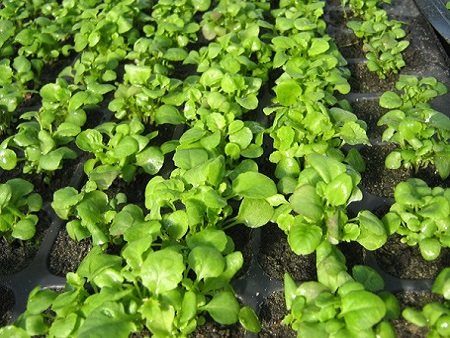

Lobelia is transplanted into open ground in late May or early June, when there is no severe frost. Lobelia should be transplanted in small groups (from 3 to 5 copies) to form a bush.
Basic transplant rules:
- Water the soil abundantly;
- Transplant the plant carefully with an earthen clod;
- The distance between the formed bushes should be 15-20 cm;
- After watering the soil (only root watering) and watering again only after it dries up, at the rate of 1 liter of water per one bush.
The plant will take root well in the open field if you hardened it and domesticated the soil before transplanting.
Description of varieties of lobelia cardinal (purple)
Lobelia cardinal or purple (Lobelia cardinalis) is a perennial, winter-hardy variety of lobelia.
Plants of this species form tall shrubs with non-drooping stems. The height of the bushes reaches a meter. The flowers are small, scarlet, collected in tall peduncles in the shape of an ear. This type of lobelia - oh, therefore, it needs abundant watering.
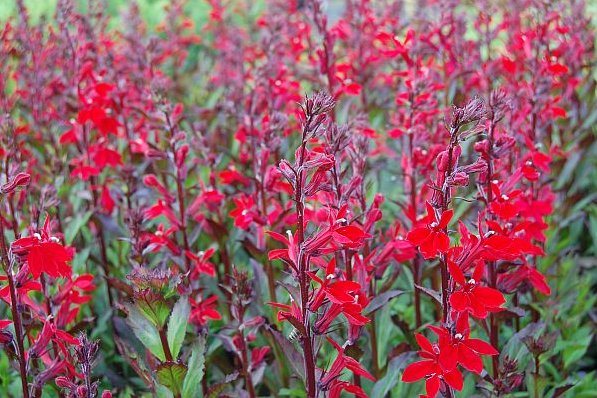

It can be planted in lowlands and swampy areas of the garden area. When planted along the shore of a pond, Cardinal lobelia grows rapidly, occupying over time not only the coastal territory, but also shallow water. When planted by a pond, the flowering of cardinal lobelia will be more magnificent. The variety practically does not freeze.
Reproduction of lobelia


Lobelia propagation is of two types: seed and cuttings.
Seed reproduction
For seed reproduction, you need:
- Prepare the soil. To do this, use a mixture of peat, earth and sand.It is best to treat it (for example, with a solution of potassium permanganate) to prevent infection;
- In early February, plant the seeds in a seedling container or peat tablets. The seedling container should be 5 cm deep, fill it with sandy soil, and put drainage on the bottom. Put the seeds on top and cover the container with foil;
- When the seedlings reach the age of 5-7 days, you can dive them, seating them in heaps of 3-5 pieces;
- Temper the seedlings by taking them to the balcony or opening a window, this in the future will help the plants to harden well in the open field and survive unplanned frosts.
You can not place seeds in the ground or sprinkle with earth, keep only on the surface.
If you want to sow lobelia directly into open ground, then do it at the end of winter, under the snow that has not yet melted. Prepare the area and place the seeds mixed with sand on the snow, the melting snow will provide them with moisture. After about 2 weeks, the seeds will sprout. Now you need to spray them until they get stronger. This method is applicable for the southern regions of our country and for frost-resistant lobelia species.
Cuttings
When grafting, there are the following rules:
- Use young shoots of the overwintered plant (which you transplanted into a pot in the house for the winter);
- Carry out cuttings in the spring, when the plant begins the active phase of growth and subsequent flowering;
- The cuttings are recommended to be treated with growth stimulants (this will help in the formation of roots), and then placed in the ground;
- The soil, like the tool, must be processed, because bacteria can penetrate through the open cut and the plant will get sick;
- Keep the cuttings under a film or a plastic bottle (to create the necessary moisture and heat), but you need to ventilate them daily;
- Cuttings will take root in three weeks, and they can be planted in a month and a half.
Species diversity
The genus of lobelia is very diverse. There are 360 plant species in it, but decorative varieties of only a few of them are more used in culture.
Lobelia Erinus. The most common plant is a perennial with a height of 10-40 cm. It forms a dense spherical bush. The internodes are close to each other, oval palmate foliage 3-6 cm long and up to 1.5 cm wide develops in them. Bright green leaves can take on a light purple hue. In June-September, the plant is covered with single axillary flowers with a diameter of 13-20 mm. Most of them are located at the tops of the shoots. In August-September, two-celled achenes ripen, which open their valves on their own and scatter seeds on the ground. Varieties:
- Reggata rose - pink flowers with a cream eye;
- Sky Blu - solid sky blue flowers;
- Regatta blue - violet-blue flowers with a yellow eye.
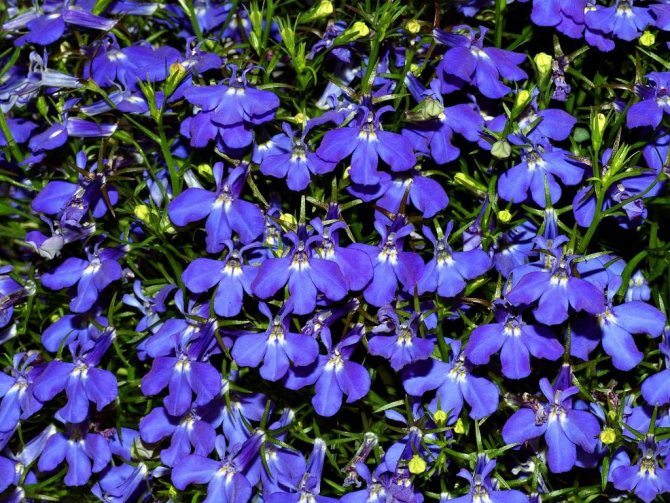

Lobelia Erinus
Lobelia ampelous (climbing). The plant is distinguished by very thin, densely leafy shoots of bright green color. Reaching a height of 10-15 cm, they begin to lean to the ground. The stems themselves can grow up to 50 cm in length. Small oblong leaves create an airy green cloud. In June, bright double-lipped flowers bloom on the surface of the bush. The upper lip consists of 2 small fused petals, and the lower one consists of three larger petals. Varieties:
- Sapphire - long drooping shoots form shoots covered with bright blue flowers with a white eye;
- Red cascade - stems up to 35 cm long bend downward, in summer they are densely covered with crimson or bright pink flowers.
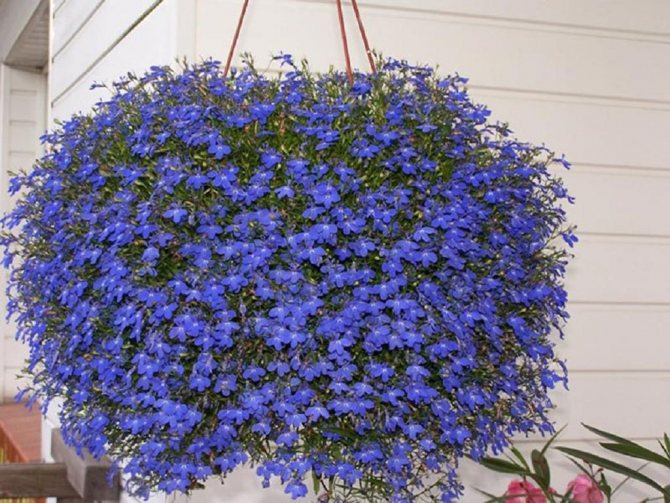

Lobelia ampelous (climbing)
Lobelia cardinal (purple). Indeed, a gigantic plant with highly branched erect shoots forms a ball up to 1 m in diameter. The stems and dark green leaves are covered with a bluish short pile. In June, long, spike-shaped inflorescences of a carmine or bright pink color bloom.The moisture-loving variety is used for landscaping the shores.


Lobelia cardinal (purple)
Lobelia Dortman (water). An amazing herb that is partially submerged in water. Erect, weakly branched shoots at the base are surrounded by a rosette of linear leaves 7-8 cm long. The foliage is completely submerged in water. At the end of July, bare shoots rise above the surface of the reservoir and dissolve single white flowers. Sometimes a pinkish or bluish tint is visible in the color of the petals.
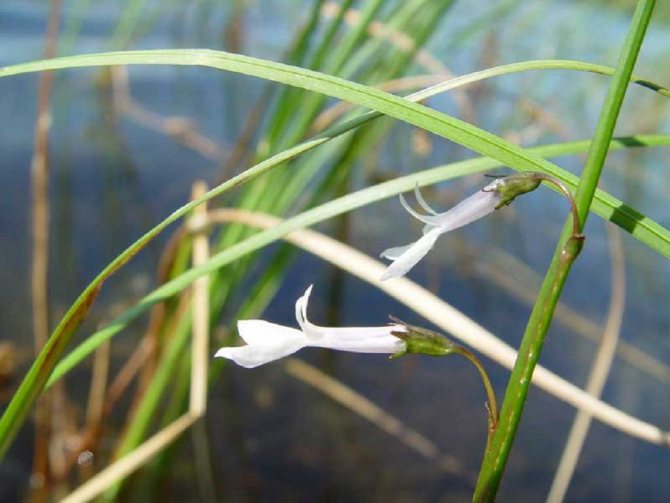

Lobelia Dortman
Lobelia is beautiful. Erect, branched stems grow 60-90 cm in height. They are covered with dark green linear leaves. At the end of June, loose racemose inflorescences with tubular flowers bloom at the tops. The diameter of the corolla reaches 3 cm. It has an asymmetrical shape and is painted in carmine red or pink. Varieties:
- Fan Scarlet - a bush up to 60 cm high dissolves a fiery red inflorescence;
- Deep Red compliment - burgundy-brown erect stems up to 70 cm high are covered with narrow green foliage, and the tops are decorated with purple inflorescences;
- Russian princess - erect stems up to 90 cm high, together with leaves, are painted in a purple-bronze color, the inflorescence consists of bright pink shades.
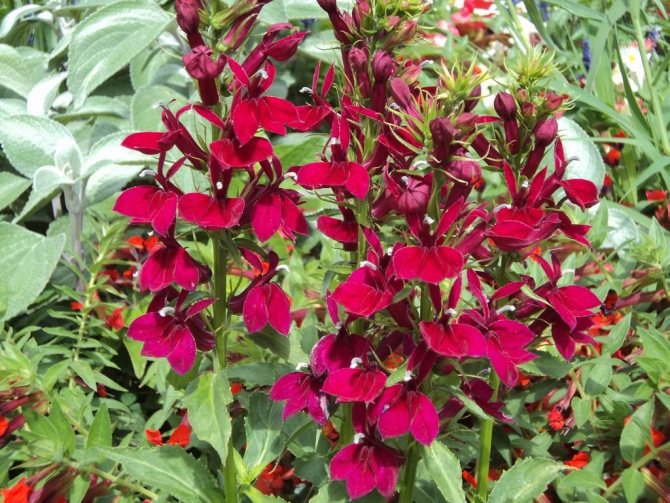

Lobelia is beautiful
Lobelia bloom
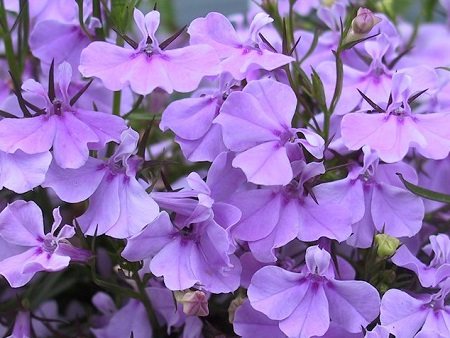

Some lobelia varieties begin to bloom while still seedlings, and end with the onset of frost. In total, it blooms for 4 months, from June to September. As soon as it fades, the so-called "first wave", it needs to be cut off by about 5 cm. Then it will bloom with the "second wave". The flowers are small up to 1 cm or large up to 2 cm. The flowers are bell-shaped, two-lipped. The color of flowers is very different, but mostly cold shades. Lobelia has no aroma.
Botanical description
Lobelia is a flowering plant with thin, highly branched shoots. There are shrubs and creeping ground cover forms. The height of the creeping shoots does not exceed 10-20 cm. Erect shoots can reach 50 cm in height. Along the entire length of the shoots, there are successive sessile lanceolate leaves. They have a solid dark green leaf plate. Stems and leaves are covered with a short hair of a bluish or silvery shade.
In the upper part of the shoots in June-July, single axillary flowers bloom on short pedicels. The diameter of the flower does not exceed 2 cm. It has a two-lipped shape with shortened upper petals. In the center there are short stamens with large anthers and an ovary. The petals can be purple, blue, white, pink, magenta, or cyan. There are plants with monochromatic petals or a contrasting eye. Flowering continues until the onset of cold weather.
Fragrant buds attract butterflies, bees and other insects. After pollination, seed pods with two compartments ripen. They contain very small dusty seeds of a dark brown color. They retain the ability to germinate for up to 3 years.
Lobelia pruning
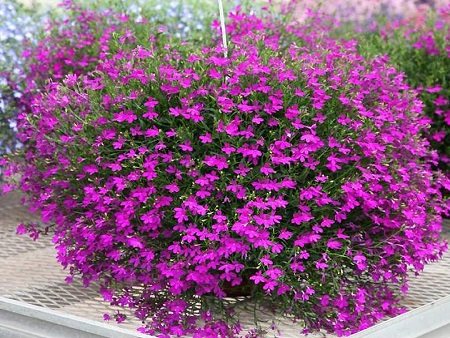

In order to keep the flowering of lobelia as long as possible, you need to cut off dried buds from the bushes so that they can be replaced with new ones. To make the plants look neat, you need to remove the stems once or twice a summer. You can also apply formative pruning (cutting off excess to give the bushes a specific shape) in addition to this will stimulate a "second wave" of flowering.
Photo
Below you can see what a lobelia flower looks like in the photo:
Lobelia wintering
Wintering lobelia is best done in a house or greenhouse. If you plan to return the plant to your home, then:
- You need to have time to do this before frost in order to preserve the flowers;
- Dig up the plant along with an earthen clod and transplant into a pot;
- Keep it in a sunny place at home, such as a windowsill.
In the house, the plant will bloom for a couple of months after transplanting.
There is also an option for wintering perennial lobelia right in the garden, but this is permissible only in areas where winters are mild. In order to prepare for wintering in the garden, lobelias do not need pruning, and only plants that grow in the first and second year need to be covered.
Varieties
In the harsh winters of mid-latitudes of Russia, lobelia usually grows as an annual. However, there are also varieties that are able to survive freezing winters and grow as a perennial plant.
Perennials have larger flowers with a thicker color.
Lobelia variety "Fine".
Both an annual and a perennial plant can be grown. The bush is tall, almost a meter in height. The flowers are large, three centimeters in diameter, bright and very numerous.
Refers to frost-resistant, grown in areas with severe winters.
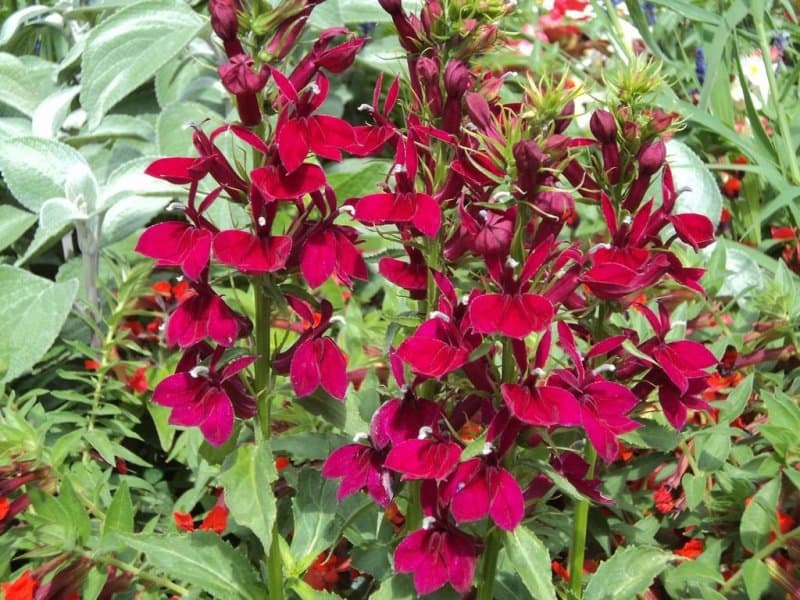

Perennial lobelia variety "Krasnaya"
This lobelia is also called fiery or shiny. Indeed, it blooms with flowers of a fiery color, there are also lobelias with leaf plates of the same color. They are very effective as a decoration for flower beds and rock gardens.
This variety is not so frost-resistant, for the winter it should be properly protected from freezing. It grows just below the meter mark, but there are also tall varieties that grow up to one and a half meters in height (among them the Queen Victoria variety)


Lobelia variety of perennial "Purple"
This variety is also called cardinal. She has erect stems that grow up to a meter in height. Feels good near the pond, loves water, even grows in water. The flowers, collected in the form of spikelets, are colored purple.
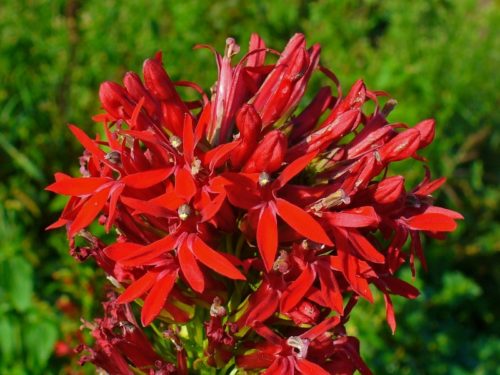

Lobelia variety of perennial "Gerardi"
Refers to frost-resistant, without shelter can survive even the most severe winters. Gherardi's flowers are rich in tones, more often purple or violet, in the form of spike-shaped inflorescences.


Perennial lobelia variety "Swallow's Nest"
Very decorative variety. It has flowers of bright blue or purple color, collected in the form of spikelets in inflorescences. Perfect decoration of balconies and terraces in a flowerpot or hanging pot.
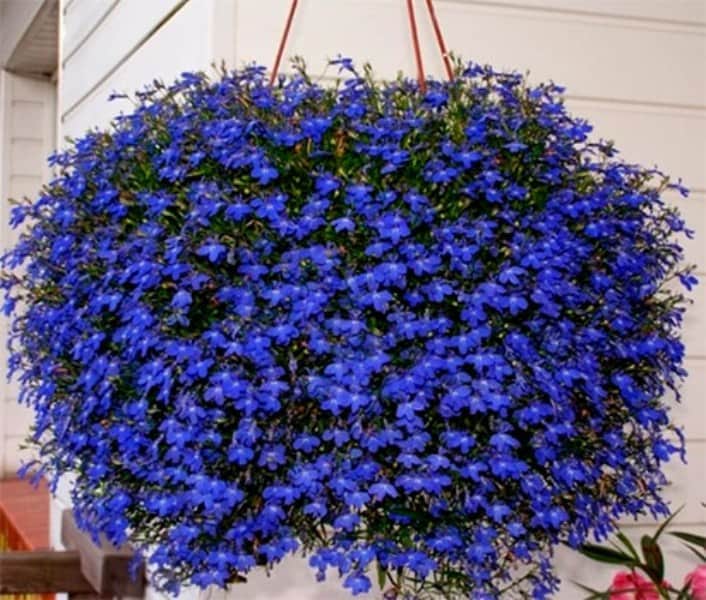

Lobelia variety "Syphilitica"
Another name - "blue", according to the color of the flowers of dark purple or blue, which the bush is literally strewn with. It grows in the wild on the American continent. The bush grows up to a meter in height.
Until some time, even the flowers of "syphilitic" were considered medicinal, supposedly capable of getting rid of the disease of the same name, but then this theory was abandoned.
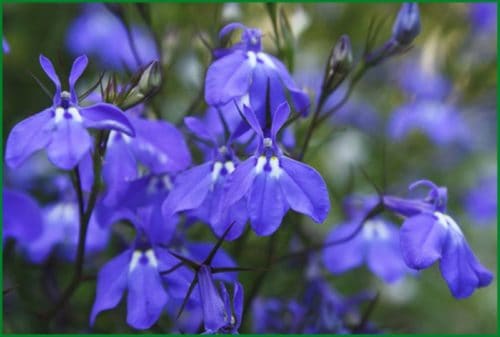

Lobelia variety of perennial "Dortman"
This is a rare, endangered plant listed in the Red Book. In natural conditions, it can be found near rivers and lakes, loves sandy soil.
The flowers of this species are small, painted in a variety of shades: from white to purple.
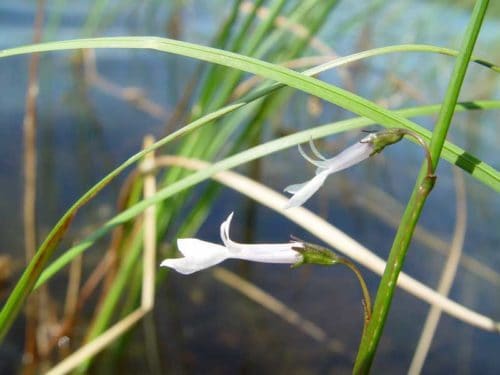

Types and varieties, video:
Diseases and pests of lobelia
- Bacterial wilting
It manifests itself in the wilting of seedlings in the sun, the plant dies. Bacteria enter the plant through the conduction system during pruning or cuttings. Use clean seed and machine the instrument.
- Stem rot
Stem Rot - Part of the stem turns gray and mold forms at this point. Then the escape fades and dies. Sometimes the whole plant can become infected. Do not use foliar irrigation - this is the main cause of the disease.
- Tospoviruses
The leaves become purple in color, with whitish spots. With a serious lesion, the leaves dry out and the shoots turn black. Affected plants do not grow or flower. It is impossible to cure, only to destroy the infected plants. It is carried by thrips.
- Thrips
A pest that sucks her juices and carries diseases. Their presence can be seen in the footprints - small white specks on the leaves. In order to get rid of them, spray the plant with insecticides.
Difficulty leaving
It is most dangerous to overmoisten the soil, which can lead to decay of the root system of the flower and its death.Common lobelia diseases are rot, powdery mildew and rust. Therefore, it is very important not to flood the bush while watering.
If, nevertheless, a fungal infection has occurred, then the diseased parts of the bush are destroyed and treated with a fungicide
Sometimes lobelia suffers from a viral mosaic. This is a very dangerous and incurable disease. Therefore, diseased plants destroy
Of the insect pests that infect bushes, the most common are: aphids, spider mites and garden slugs
- Slugs often come at night to feast on lobelia stalks. They are frightened off by the smell of bleach. Placed bowls with a pungent smell will make the slugs go away
- Spraying the bushes with laundry soap diluted in water will help from gluttonous aphids
- If thin cobwebs appear on the bushes, characteristic of a tick that sucks the juices from the plant, then you should use the infusion of garlic here. For severe lesions, use special chemicals
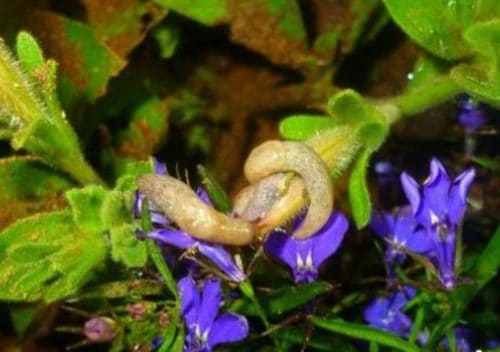

Proper care will allow you to admire the beautiful flowering of lobelia for more than one year.
Note to the gardener


Why did lobelia dry up by the end of summer? If you have not done anything with the plant, then the problem is the lack of nutrients in the soil. By the beginning of summer there were many of them, but by the end they were almost all over. Also, if you did not cut the bush, then there was no rejuvenation. Do you have to pinch lobelia? It depends on the species. You can pinch an erect and compact lobelia, but an ampelous one is not necessary at all. Pinching is used so that the shoots grow in breadth, and not upward. To do this, remove the apical growth points. You can do it when the seedlings have reached a height of 6-7 cm. If you do this for the first time, the result may not be positive.
Lobelia blue (Lobelia siphilitica)
Lobelia syphilitica or blue lobelia (Lobelia siphilitica) is a perennial plant.
The blue or purple flowers of this type of lobelia are collected on spikelet-shaped inflorescences. The bush is tall, erect, not spreading. The variety was brought from America. The name of the plant was given by mistake at the time when this type of lobelia was introduced to Europe.
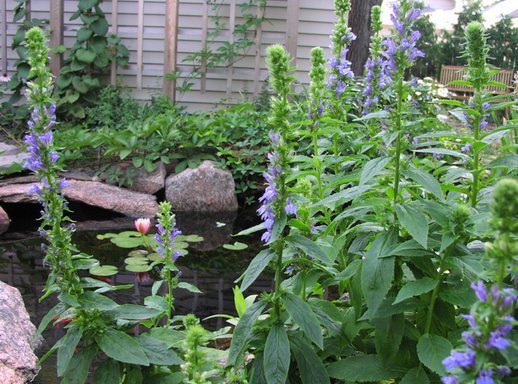

People believed that this flower cured syphilis. The delusion was dispelled over time, but the name remained. The view does not differ in particular decorativeness, therefore it did not receive much distribution. But it served as the basis for breeding hybrid forms of lobelia. The result of crossing blue, purple and shiny lobelias is the well-known variety Compliment.
Love care videos
In general, lobelias are unpretentious and the main activities that need to be spent time and effort take place during the care of the seedlings. It must be planted in several plants together, then it will bloom with beautiful bushes.
You can extend its bloom by replanting the plant into your home. And even if you did not have time and during the first frost the flowers froze, then after transplanting in two weeks new ones will appear. The main rule is a well-calculated watering, so as not to dry out or flood the plant.
You can also share your lobelia care secrets. If you have any questions - ask them in the comments below, we will be happy to answer them.
Spectacular appearance
The corolla of lobelia is two-lipped, consists of five petals fused into a tube. Two of THEM are less accrete and directed upwards, the remaining three look down and often form a semblance of a serrated lip.
RARE PLANT SEEDS FOR YOUR GARDEN - FREE SHIPPING. PRICES ARE VERY LOW. THERE ARE REVIEWS


Many species are distinguished by abundant flowering, and the flowers have a very intense color, including quite rare in nature: bright red or pure blue.
How to care for a plant?
Lobelia is an unpretentious plant, but when growing it, you need to take into account some subtleties:
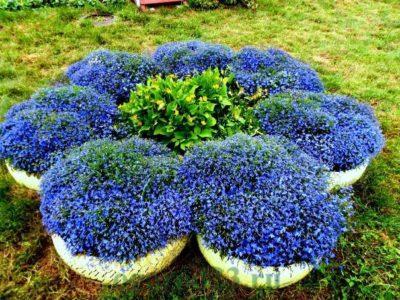

The plant is thermophilic. Lack of heat will not kill the plant, but flowering will not occur abundantly.- Lobelia blooms especially well in slightly shaded areas of the garden or balcony. Direct sunlight in the morning is acceptable.
- Lobelia is demanding on soil moisture, it needs to be watered regularly. Watering is best done in the morning or evening to prevent burns on the delicate leaves.
- Protection from rain and wind. Heavy rain or gusty winds can damage the fragile plant.
- Dried flowers should be removed regularly to make room for new ones to grow.
- It is recommended to use mineral fertilizers for feeding. Feeding is worth no more than two times per season. If the plant is in a pot, then you can increase the amount of dressings to 3-4.
Important! Be careful - if you overfeed the plant, it will grow, not bloom. - When choosing a lobelia pot, make sure it is deep enough and has drainage holes.
Annual plant
Of all the annual lobelia, only one species is most common - erinus. It also has the name “black”. Also common under the name long-petiolized lobelia. The plant has got thin stems, the leaves have small teeth. Due to the huge number of shoots, already an adult lobelia is a ball of dense shape, consisting of flowers. The latter are small in size (2 cm), but there are many of them. One bush contains about a hundred flowers. It is about her that will be discussed further in the article. Let's consider in detail the possible varieties and how to care for the plant.


When to sow seeds for seedlings?
Lobelia erinus (blackberry) is a perennial, which in our climate is usually grown as an annual plant. It is very simple to calculate the timing of sowing seeds for seedlings: the beginning of flowering occurs 70 - 80 days after sowing. Seeds are sown from February to late March (in extreme cases, early April). If there is no additional lighting in the house; then it is better to start sowing lobelia seeds for seedlings in March. March seedlings often not only catch up with the February ones, but also turn out to be stronger. April seedlings bloom by mid-summer.
Collection and storage of seeds
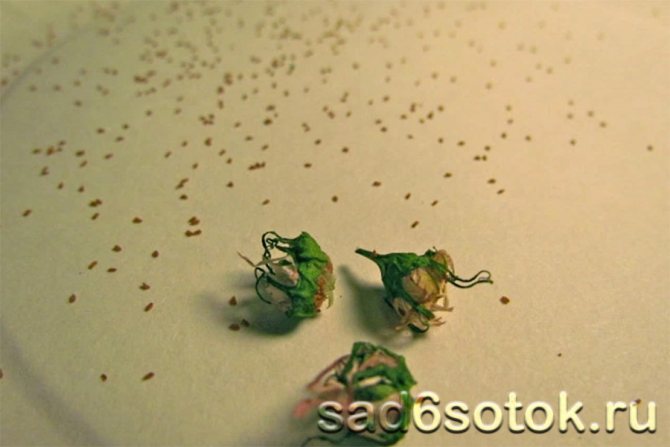

Lobelia capsules and seeds
Lobelias produce small, numerous seeds that develop in small bivalve capsules. Seeds are oblong, very small - no more than 0.6 mm long, shiny. The color depends on the color of the flowers - for white lobelias, the seeds are light cream, for dark ones - brown.
The seeds ripen from the end of August, they begin selective collection in dry, calm weather, waiting for ripening, and preventing the opening of the capsules as soon as they turn light brown. Collect the boxes together with the shoots and lay out on paper for ripening and drying, marking the variety.
After drying, the flaps are kneaded with your fingers, the garbage is removed and the seeds are packed in paper bags, the name of the variety, the collection time, and stored in a cool dry place.
Advantages and disadvantages
Main advantages:
- Lush, abundant flowering is characteristic, which can last until the first frost.
- Combines with different types of flowers (marigolds, alyssum, petunia, mimolus). You can make beautiful compositions in a flower bed or in a pot. An abundance of multi-colored shades is characteristic.
- Loves a lot of sunlight and moisture.
- Possesses good cold resistance.
The disadvantage of lobelia erinus is that it does not tolerate high frosts, so the bush must be dug out for the winter.
Methods
Seeds
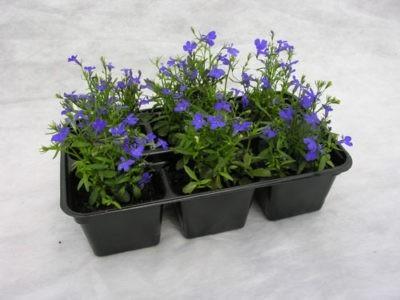

Sowing seeds is done at the end of February, sometimes in January, but then additional lighting is required. The difficulty with this method is that the procedure for growing seedlings from seeds is laborious and time-consuming. In the first stage of growth, lobelia grows very slowly.
The advantage of sowing seeds is the reliability of the method.Seedlings obtained by self-sowing are distinguished by 100% quality of future flowering, they take root well even in open ground, do not get sick and resist garden pests and diseases.
How to choose?
Lobelia seeds Erinus have a fairly long "shelf life", retain their qualities for up to 4 years. The seeds have structural and size features - only 1 g contains up to 30 thousand seeds. For planting 1 flower bed, you will need only 0.5 grams.
To evenly distribute them in the greenhouse, the seeds are usually mixed with sand and peat, in a ratio of 1: 5, or planted on snow, having previously spread it in a thin layer, up to 1 cm thick, on the surface of the substrate.
Note! When sowing, the seeds are not embedded in the soil, only slightly pressed against it.
Procedure order
Sowing seeds of Erinus lobelia is usually carried out at the end of February. From the very autumn, a soil mixture is prepared:
- Sod land - 1 hour
- Horse peat - 1 tsp
- Sand - 1 tsp
Humus should not be added to the sowing substrate - the sprouts may suffer from the Blackleg fungus.
The landing box or container should be low and spacious; you can use a food container with a transparent lid. Seeds ripen only in good lighting conditions, so most often the crops are additionally illuminated with special lamps.
The procedure for planting lobelia Erinus seeds is performed sequentially:


The finished substrate is poured into the planting container, in a small layer up to 5 cm.- The substrate is moistened, slightly compacted.
- Seeds are sown mixed with sand or peat.
- Sowing is not sprinkled with a substrate.
- The sowing is moistened evenly from a fine spray.
- The container is covered with glass or foil.
- Air every day for 20 minutes, gradually increasing the airing time to 1.5 - 2 hours.
- Wipe off condensation from the film.
- Seedlings appear in 7 - 9 days with thick bristles.
- Watering is carried out only by spraying.
- The film or glass is removed completely when the sprouts grow up to 3 cm so that the seedlings are hardened.
- A month after sowing, picking is required - transplanting sprouts.
- A pick is usually carried out with a teaspoon or a special spatula.
- 6 sprouts are transplanted into separate small pots or peat cups.
- As soon as the seedlings reach 2.5 - 3 cm in height, the tops must be cut off.
- Pruning is carried out 2 - 3 times every 3 - 4 weeks for good tillering of the flower.
- Air temperature for seed germination is not less than 19 ° С.
Important! Water to moisten the soil should be warm, settled.
For primary moistening, immediately after planting, it is advisable to add potassium permanganate to the water to disinfect the substrate and prevent seedling diseases. Watering should be gentle, moderate.
Cuttings
Reproduction by cuttings of Erinus lobelia is rarely used, only with those hybrid varieties that do not produce seeds.
It is necessary to prepare in advance the soil for grafting, choose the desired container, follow all the rules of care and cultivation.
Advantages and disadvantages
This method can only be used for double-flowered cultivars and Erinus lobelia hybrids. Propagation by cuttings does not take much time, the rooting of cuttings is quick, the procedure itself is simple.
Preparation


For reproduction of lobelia Erinus, an adult bush is usually used., with well-developed and healthy, strong shoots. The flower is dug up at the end of autumn and transferred to the house for the winter. They take care of them as for other indoor flowers, the temperature of the content is 18 - 20 ° C.
Cuttings are cut in the spring. The tops of the shoots are cut off with a length of 8 - 10 cm. Before planting, it is advisable to treat the slices with any growth stimulator, usually root is used.
You can prepare a mixture for grafting yourself:
- River sand - 1 tsp
- Vermiculite - 1 tsp
Step-by-step instruction
Cutting is usually carried out in March so that the seedlings get stronger for planting in open ground.
Reproduction scheme by cuttings of Erinus lobelia:
- Cuttings are cut obliquely up to 10 cm long.
- The bases of the cuttings are treated with a growth stimulant.
- Cuttings are planted in a pre-prepared sand mixture.
- The seedlings are covered with foil or glass jars.
- Airing of the cuttings is required every day for 20 minutes.
- Rooting conditionally occurs in a month.
- Top dressing is introduced once a week.
- Liquid complex mineral fertilizers are used more often.
- After 1, 5 months from the moment of planting, the seedlings are transplanted into open ground on flower beds or flower beds.
On a note. Watering for rooting cuttings should be regular, the substrate is moistened as it dries. It is impossible to overdry the soil. Water is used warm, clean or settled for at least 2 - 3 days.
Optimal conditions for growing a flower
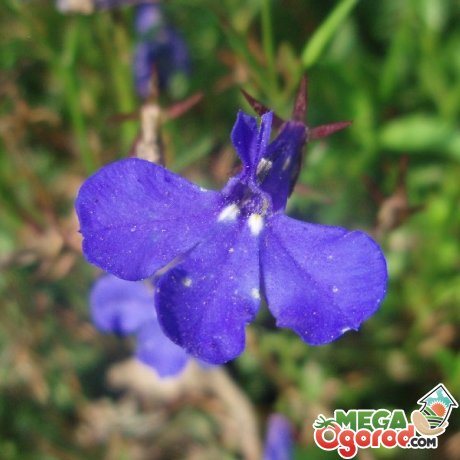

It is worth paying attention to the following characteristics of lobelia:
- Cold resistance
- Photophilousness
- Moisture-loving
Therefore, when growing this plant, you need to plant it in a place well-lit by the sun and water it regularly. Timely watering is the main condition for successful growth and abundant peduncle. During a period of drought, high temperatures and dry air, if you do not adhere to this condition, then the plant will simply grow poorly and even stop producing flowers.
An important condition for optimal cultivation is the selection of the soil.
It should be loose, nutritious and free of excess organic fertilizers. Do not feed her with fresh manure. The flower cannot bear it. It is best if the soil is fertilized even before the plant is planted in the ground. Otherwise, it will actively grow, but not bloom at all. Knowing these conditions, you can grow beautiful plants without much effort on your part.
Lobelia in garden design
The rich color gamut of lobelia is often used to create incredible patterns and compositions. Photos amaze with the fantasies of landscape designers who work wonders with these flowers.
Everyone can create a summer extravaganza with lobelia.



